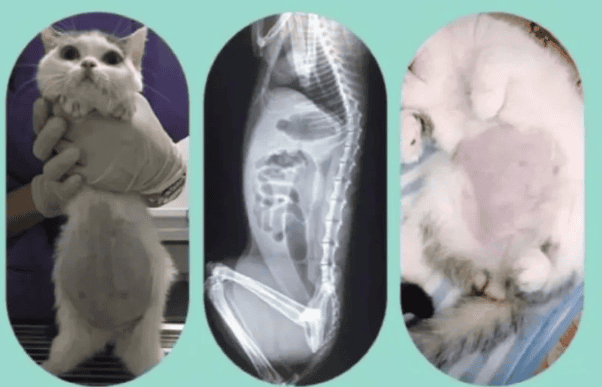Pet cats are an indispensable member of the family and society, and their health and happiness are one of their owners' greatest concerns. Therefore, owners also need to have a certain knowledge and understanding of various diseases and health problems that cats often encounter in order to detect them in advance and deal with them in time. Let’s learn about some common diseases that cats may face and how to deal with them!
01
Feline infectious peritonitis
Feline infectious peritonitis is a chronic progressive infectious disease of cats caused by feline infectious peritonitis virus , clinically characterized by peritonitis, massive ascites accumulation and high mortality.

Symptoms
The early symptoms of the disease are not obvious or characteristic. Sick cats are often accompanied by weight loss, loss of appetite or intermittent anorexia. Subsequently, the body temperature increased to 39.7℃-41℃, and mild respiratory symptoms were seen. After 7-40 days, obvious abdominal girth enlargement can be seen, and a large amount of ascites accumulates in the abdominal cavity. There is generally no obvious pain when the abdominal wall is palpated. As the abdominal circumference gradually increases, sick cats may show symptoms such as dyspnea, anemia, and weight loss. After a few weeks of illness, the cat will collapse and die.

Pathogen
The pathogen is coronavirus, which is resistant to the external environment No, commonly used disinfectants can kill the virus. Cats aged 1 to 2 years old and older cats are more susceptible to the disease, and purebred cats are more common in domestic cats.
The virus has a certain affinity for the eyes, central nervous system, kidneys and liver, and the above organs rarely show symptoms of ascites. Symptoms of keratitis and conjunctivitis may be seen when the eyes are damaged; hindquarter movement disorders, movement disorders, and spasms may be seen when the central nervous system is damaged; jaundice and indigestion symptoms may be seen when the liver is damaged; and palpable palpation may be seen when the kidneys are damaged. Symptoms such as kidney enlargement, anemia, proteinuria, and renal failure may occur in sick cats.
Feline leukemia virus infection
There are two types of feline leukemia, one is lymphoma, erythroblast or myeloblastic leukemia, and the other is mainly immunodeficiency virus . This type of disease is contrary to the abnormal enhancement of cells in the previous type. It is mainly characterized by cell damage and cell development disorders, and is characterized by anemia caused by thymus atrophy, lymphopenia, neutropenia, and bone marrow red blood cell development disorders.
Pathogen
Feline leukemia virus is mainly spread horizontally among cats. It can be spread through the respiratory tract, digestive tract, and vertically. Pregnant female cats can infect their fetuses through the uterus. .
Feline leukemia virus mainly causes infection in cats. There is no difference in gender and breed. Kittens are more susceptible than adult cats in terms of age. The virus is not transmitted from person to person and does not pose a threat to human health.
Symptoms
The incubation period of this disease is generally long and the symptoms are diverse. It can generally be divided into two categories: neoplastic diseases and immunosuppressive diseases:
Neoplastic diseases
a. Gastrointestinal lymphoma: Mainly characterized by the occurrence of B-cell lymphoma in the lymphoid tissue of the digestive tract. Sometimes the spleen, liver and kidneys can be affected. Clinical manifestations include loss of appetite, weight loss, pale mucous membranes, anemia, vomiting, diarrhea and other symptoms. This type accounts for approximately 30% of all cases.
b. Multiple lymphoma: The main manifestation is swollen lymph nodes in multiple parts of the body. Superficial lymph nodes on the body can often be touched with hands. Clinical manifestations include weight loss, depression and other symptoms. This type accounts for about 20% of cases.
Immunosuppressive diseases
The main causes of death in cats with immunosuppressive diseases are anemia and leukopenia.
The envelope protein antigen of leukemia virus has an immunosuppressive effect and has a strong pathogenic effect on T cells, especially immature thymic lymphocytes, thereby reducing the number and function of T cells. As a result, the body's defense function is lost, white blood cells decrease, and the body is unable to protect against the invasion of foreign pathogens, eventually leading to systemic infection and death.

Cat rabies
Cat rabies is the same as the dog rabies virus, also known as hydrophobia disease. It is characterized by the sick cats being restless, confused, overreacting to environmental stimuli, attacking other animals, and finally becoming paralyzed and dying.
Feline rabies virus is not heat-resistant and is inactivated in 2 minutes at 100°C and 1 hour at 50°C. It is sensitive to acid, alkali, formalin and other disinfectants. 70% alcohol, 0.01% iodine solution and 1%-2% soapy water can also inactivate the virus.
Symptoms
The incubation period of this disease varies depending on the location of the wound and the virus content, and the duration of the disease ranges from 2 to 4 days. In the early stage, the sick cat hid in the dark, barked, resisted excessively, and reacted excitedly to sound and light; then it became manic and restless, aggressive, had fierce and straight eyes, did not listen to the owner's orders, gradually became depressed, walked unsteadily, and its hind limbs were paralyzed and collapsed. He died of general exhaustion.
Transmission characteristics
Sick and virus-carrying animals are the main source of infection of this disease. The virus mainly exists in the saliva of sick animals, and symptoms occur 15 days before the onset of clinical symptoms. Toxicity persists for 10 days after disappearance. Healthy cats are mainly infected through wounds (skin scratches, bites, damaged mucous membranes, etc.) and can infect humans.
Do not bandage the wound after a cat bites someone. Squeeze out the blood in multiple batches and rinse with soap and water promptly.
To sum up, cats’ health problems require us owners to remain vigilant and pay attention at all times. Through timely prevention, observation and treatment, we can help cats overcome the difficulties of the disease and keep them healthy and happy with us for a longer time. Living with cats means paying attention to their health and happiness, so that they can enjoy every day without any worries!

 扫一扫微信交流
扫一扫微信交流
发布评论